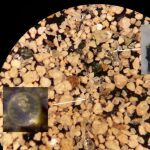Life Is Common in the Universe, New Analysis of Meteorites Suggests0
- From Around the Web, Space
- January 17, 2018
Is there life on other planets?

Is there life on other planets?

Two wayward space rocks, which separately crashed to Earth in 1998 after circulating in our solar system’s asteroid belt for billions of years, share something else in common: the ingredients for life. They are the first meteorites found to contain both liquid water and a mix of complex organic compounds such as hydrocarbons and amino acids.

100 years ago this weekend, a meteorite ended its 4.5 billion-year journey through space when it blazed across the skies and crashed into the Strathmore countryside. Michael Alexander learned about a fragment now housed in Dundee.

How could people living during the Bronze Age pull off the difficult process of making iron?

How something as small as meteorites can change how we view something as big as Mars.

A cluster of recent meteorite impacts on Mars have been found, highlighting a deadly hazard for future Mars colonists.

Laser-zapping of a globular, golf-ball-size object on Mars by NASA’s Curiosity rover confirms that it is an iron-nickel meteorite fallen from the Red Planet’s sky.

A meteorite may have hit the surface of the Earth about 56 million years ago, raining debris for hundreds of miles across the Atlantic Ocean and what is now the East Coast of the U.S.

Like cosmic ballet dancers, the stars of the Pleiades cluster are spinning. But these celestial dancers are all twirling at different speeds. Astronomers have long wondered what determines the rotation rates of these stars.

A slice from the 4.5-billion-year-old Allende meteorite. This rock was formed along with the solar system.